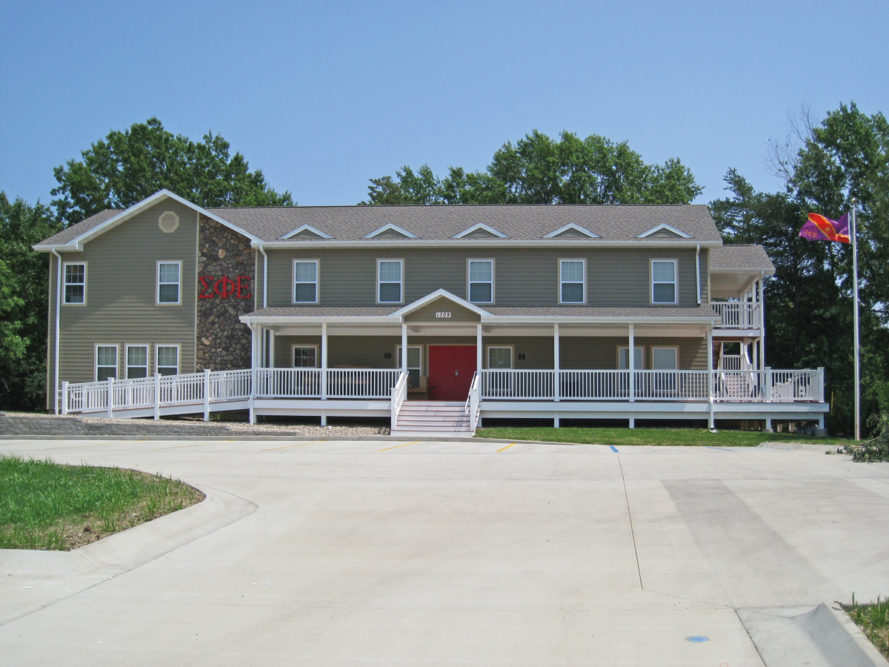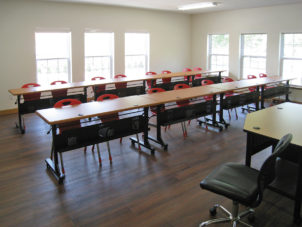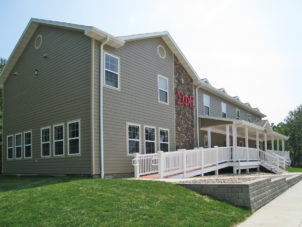In 1981, a new SigEp chapter was chartered on the campus of Truman State University (then Northeast Missouri State University). With groundbreaking programming and a desire to set themselves apart from other, stereotypical fraternities on campus, members recruited top scholars, leaders and athletes from the student body. Within a few years, the Missouri Mu Chapter of SigEp became one of the largest fraternities at Truman State. The chapter boasted one of the top GPAs among any men’s organization, developed leaders of numerous campus associations and groups, and began a more than three-decade dynasty as frequent winners of the Intramural All Sports trophy.
In the mid-1980s, the chapter purchased its first facility. The building was a small, 30-year-old, ranch-style residential home that sat on a little over an acre. Though not an ideal facility for a fraternity, it was situated in a highly desired location adjacent to campus. With some imagination and a little ingenuity, undergraduates converted the family residence into a facility that could house 26 members and serve as a gathering place for the brothers to study, socialize and celebrate.
But by 2014, the condition of the SigEp house at 1309 South Florence had deteriorated. The Alumni and Volunteer Corporation (AVC) made the very tough decision to close it and explore other housing options for the undergraduates. Upkeep on the property had become expensive over the years and left the chapter accounts with very little money. The undergraduate chapter was thriving and needed a facility that fit the outstanding programming and experience members enjoyed.

Around that time, Truman State graduate Matt Finke, ’04, was serving as Missouri’s lieutenant district governor. He began working with the AVC and long-time chapter advisor Dr. Roger Festa, Truman State Renaissance, on a plan to provide stability along with ongoing alumni support and resources for the chapter.
He recalled the difficult discussions regarding the future of the house and the chapter. “About a year before we made the decision to close the house, we had started preliminary discussions about developing a housing facility that aligned with the Balanced Man Program and was representative of the chapter’s high level of historical achievements,” Finke said. “AVC member Todd Birkenholz [’00], presented the idea of ‘friend-raising before fundraising,’ so we started recruiting alumni to get involved with the chapter.”
Finke also started conversations with SigEp National Housing to gather information about how to conduct a capital campaign associated with a major renovation or new facility. He began reaching out and engaging with alumni from all eras of the chapter. At that point, the chapter roll was up to nearly 800 initiated men, with many of the alumni at the mid-level of their careers. While a few were skeptical or disinterested, most were receptive to helping the chapter.

With the backing of the AVC, led by Birkenholz; Brian Winkler, ’00; and Matt Carroll, ’00, Finke created a fundraising and construction committee that would determine the direction for the facility and be responsible for planning, executing and delivering the plan for a new state-of-the art Residential Learning Community. Finke reminisced about his alumni recruiting efforts for the committee, stating, “Recruiting alumni for a project like this is easy if you are able to locate brothers that are passionate about the experience that SigEp provided them when they were undergraduates. Initially, I was able to get commitments from three key alumni brothers who became instrumental in driving the project to success: CPA Eric Janson [’96], real estate attorney David Woods [’96] and sales specialist Matt Judkins [’95]. They jumped at the idea to participate, and their involvement lent instant credibility to our efforts.”
The group added several other members to the committee, including Chris Janson, ’92, who had a history in property and facility management. Matt Stack, ’98, a real estate developer located in St. Louis, also joined the committee, serving as a design and layout consultant. Overall, the committee was a veritable dream team of real estate, construction, finance and sales experts, and their counsel and expertise would prove instrumental in the planning and development of the facility.
A plan comes together
By the spring of 2015, they developed a detailed plan to assess the property and the house. The group then engaged fundraising experts Pennington & Company to conduct a feasibility study to estimate the amount that could be raised in a capital campaign and drew up a financial plan to carry out the endeavor. They also engaged colleagues in their respective fields and university administrators to study student life on campus and assess local rental prices, taking into consideration the size of Greek organizations on campus and accounting for trends in student life.
The property assessment led to the decision to tear down the existing house and build an entirely new structure. At the same time, results of the fundraising feasibility study showed the potential to raise between $750,000 and $1 million. Additional research with architectural firms and building contractors indicated it would take $900,000 – $1 million to build the new house. The committee realized it would be possible to raise enough to substantially pay for the new facility over a short number of years, enabling the AVC to hold a smaller long-term mortgage. With the data and research in hand, the committee decided to set a goal of raising $1 million.
In order to hit that goal, a silent fundraising phase was started. Early on in phase one, lead donor Patrick Fontana, ’95, committed a major gift to the project. His generous gift provided the momentum to move forward, and within nine months, the team had gathered nearly 200 commitments. The final commitment came from the second largest donor, Bradley Parker, ’02. The two bookend contributions totaled more than 20 percent of the amount needed and brought the campaign total to nearly $1.1 million.

As part of the plan, Woods and Eric Janson worked with local banks to secure bridge financing to begin construction and provide funding while the donations were being received. A concept for the new house was created, and the plans to bring a SigEp Learning Community to campus were finalized.
In September 2017, demolition of the previous house commenced and within a month, construction began on the chapter’s new home. The building was completed in July 2018 and opened in time for the 2018-2019 academic year. The 7,000-square-foot facility houses 19 members. In addition, the home contains a classroom and study rooms, ensuring that brothers will always have a quiet place to concentrate on their studies. The chapter will also make these spaces available to other campus organizations and university professors.
The alumni group had little experience in fundraising or building a fraternity house, but under the leadership of Finke, Woods, Judkins and the Janson brothers, it developed a detailed plan to execute what many believed was a misguided dream. Through their constant diligence and tireless efforts, they delivered on their lifetime responsibility to the brotherhood of Sigma Phi Epsilon. Thanks to their dedication, the chapter now has a cornerstone facility that undergrads can call home and where future alumni will return long after graduation to provide continual support.









Leave a Reply